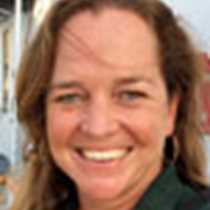Santa Cruz Island, Galápagos
After a long navigation we finally dropped anchor in the picturesque Academy Bay, on the southern coast of Santa Cruz, second largest island in the Galápagos. A very different scene awaited us today, as we had gotten used to wilderness and lack of human habitation by this stage in our expedition. In this turquoise-watered bay we were surrounded by colorful sailing and motor vessels, and could see the large town of Puerto Ayora beckoning us from the coast.
Santa Cruz is truly the economic hub of the archipelago, the tourism nerve-centre of the Galápagos. As such, we were all exposed to the modern-day reality of the islands and the problems they face, which had been invisible until this day: increasing pressures of population and tourism, large numbers of introduced species of both plants and animals, increasing construction and habitat modification. We took comfort, however, in that the Galápagos are inhabited in just 3% of their total surface area, and we also learned how inhabitants and this same infrastructure is a part of the solution as well as the problem.
We spent the morning visiting the conservation institutions that have played such an important part in the preservation of the islands, and whose relentless hard work is ensuring the future of the Galápagos: the Galápagos National Park Service and the Charles Darwin Foundation. Our main focus was on two of the programs that have literally brought some of the most important species of the Galápagos back from the very brink of extinction: the Galápagos giant tortoises and land iguanas.
The plight of the Galápagos tortoises was highlighted to the world by a very charismatic individual: a large, saddle-backed tortoise named Lonesome George, who is the very last individual left of his species, the Pinta Island tortoise. Although it is probably too late for the Pinta tortoise, huge efforts over the last 30 years have ensured that none of the remaining tortoise species meet the same fate and it was very interesting to see this hugely successful program for ourselves.
But Santa Cruz is not all about problems and solutions – it also has a fascinating natural history that we explored all afternoon. This now-extinct volcano shows many signs of a highly-active geological history, as it is dotted with parasitic cones and riddled with lava tunnels and sunken pit craters, of which we came across great examples on our different hikes. Being one of the 5 islands that are tall enough to intercept the dense inversion layer that forms during the cool season, the highlands spend most of the year immersed in the clouds and swirling mists, giving rise to different vegetation zones that are a huge change from the coastal and arid zone ecosystems we have explored over the past few days. The most spectacular of these is the giant Galápagos daisy (Scalesia pedunculata) cloud forest, where these giant members of the Compositae have formed a belt of dense forest covered in epiphytes and home to many of the Darwin finches that are not found in the lowlands. Much of this fascinating ecosystem has disappeared as these fertile soils were also sought after by the early colonists, but Santa Cruz has the largest stands remaining in the archipelago.
The island is also home to a healthy population of giant dome-shaped Galápagos tortoises in the wild, and the roads and farms on this inhabited island give us access to the usually unreachable habitat of these gentle giants. For this we were thankful, as nothing can compare to seeing these enormous animals, relics of another era, going about their daily lives as they have for millennia, despite the changes around them.




